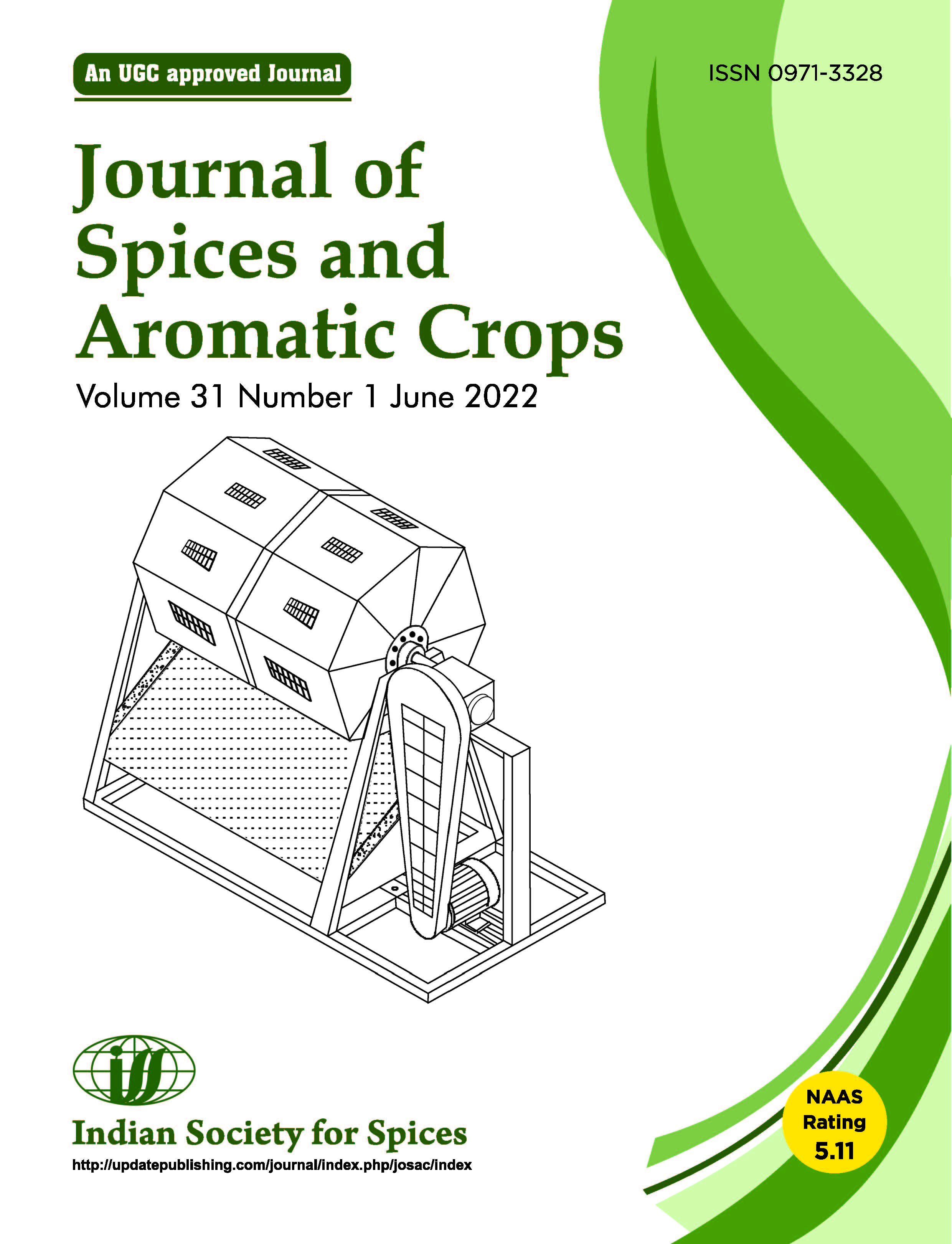Impact of cluster-based technology transfer on profitability of ginger cultivation by small hill farmers of Shivalik region of Haryana
Impact of cluster-based technology transfer in ginger
DOI:
https://doi.org/10.25081/josac.2022.v31.i1.7494Keywords:
cluster approach, productivity, technology transfer, Zingiber officinaleAbstract
Ginger (Zingiber officinale) is an important commercial crop of Morni hills of Haryana Shivaliks. There was considerable gap between the actual yield and income than the potential indicated by successful growers. In an attempt to bridge this gap by adopting a cluster development approach, 32 ginger growers of a hill village were formed as a common group to implement the recommended package of practices based on soil test analysis and adopted over one bigha (1/12th of hectare) of 32 demonstration plots and one bigha was kept as untreated control with farmers’ normal practice. The beneficiary farmers were provided trainings, exposure visits and interaction with agricultural experts. The average fresh ginger rhizome production in treated plots was 11.19 t ha-1 as against 6.97 t ha-1 in control plots. While 84 percent farmers obtained an yield of 11 to 12 t ha-1, yield recorded by remaining farmers ranged from 7.44 to 9.63 t ha-1 thus indicating scope of further increase in production. The ratio between seed used and rhizome yield was taken as an indicator of yield potential and this was 4.04 in case of treated plots and 2.65 in case of control thus registering overall increase of 52.4 percent. The total gross and net returns were Rs 996678 and 395925 ha-1 and the average cost of cultivation was Rs 600753 ha-1. The overall benefit cost ratio was 1.66. However, in case of control plots, the average gross and net returns were Rs 532800 and Rs 106972 with a benefit cost ratio of 1.22. In the cluster based approach, reduction in input costs and collective marketing resulted in better dividends.
Downloads
References
Apeda 2022 Production of Ginger across Indian States during 2021.
Bhat B S, Murthy C & Yusuf M 2012 Economics of production of ginger in Uttara Kannada district of Karnataka. Int. J. Agric. Econ. Stat. 3 (1): 181–185.
Chalise D P, Ghimire S, Neupane J & Devkota K 2019 Economics of production and marketing of ginger in Sunsari district, Nepal. Acta Scientific Agriculture. 3(11): 193–198.
Dewanarayana T B & Wimalaratna W 2018 Challenges and prospects of ginger farming in Sri Lanka with special reference to Plogahawela divisional Sectratariat divison. Int. J. Econ. Bus. 17(3): 63–69.
FAO 2019 Ginger farming guide. Publication of FAO Regional Office Bangkok. 1–18.
Grewal S S 1995 Sukhomajri concept of integrated watershed development. J. Soil and Water Cons. 39 (3&4):152–165.
Grewal S S 2002 Implementation of soil conservation programs in foreign funded watershed development projects: Analysis of some critical issues. J. Soil and Water Cons. 1(4): 304–311.
Grewal S S 2018 Rooftop and natural spring water harvesting for promotion of vegetable cultivation in drought prone Morni hills of Haryana state. J. Soil and Water Cons 18(3): 140–145.
Hannaway D B 1985 Foothills for food and forest, Timber Press Beaverton, Oragon. U S A.
Kadam A S, Suryawanshi R R, Dhengale S S & Shinde H R 2019 Economic analysis of production of ginger in Sangli district of Maharashtra. Int. J. Chem. Stud. 7(6): 1456–1460.
Karthick V, Alagumani T & Anbarassan A 2015 Growth and export performance of ginger in India – an economic analysis. Economic Affairs. 60(2): 207–214.
K V K 2015 Improved production technology of ginger. A publication of ICAR Research Complext for NEH Region Manipur.
Mathew M, Vani N & Aparna B 2016 Economics of production of ginger in Wayanad district of Kerala, India. Asian J. Res. Marketing 63(3): 627–632.
Mawlong M 2017 Ginger cultivation in Umroi, Ri Bhoi district, Meghalaya. J. Humanities and Social Science. 22 (7): 36–45.
Rajashekhar & Kumar D 2017 Cost and return of ginger in Bidar district of Karnataka an economic analysis. J. Pharmacogn Phytochem. 6(5): 472–475.
Sharath A M & Dhananjaya K B 2015 Organic farming in India – a study of ginger cultivation. Int. J. Educ. Res. 2(6): 50–61.
Sharda A M 2016 Growth rate of area, production and productivity of ginger crop in Karnataka. International Registered and Referred Monthly Journal 151(6): 8–10.
Shinde S E, Shelke R D & Bodakhe G M 2020 Economics of ginger production in Aurangabad district of Maharashtra. Int. J. Cur Microbiol. Appl. 9(12): 549–554.
Yadav R K, Yadav D S, Rai N, Sanwal S K & Sharma P 2004 Commercial prospects of ginger cultivation in North Eastern Region. Himalayan Ecology ENVIS Bulletin 12(2): 24–28.
Yadav R P, Panwar P, Arya S L & Mishra P K 2015 Revisit of Shivalik region in different states of North western India. J. Geol Soc. India. 86: 351–360.
Published
How to Cite
Issue
Section
Copyright (c) 2022 S S Grewal, J S Kanwar

This work is licensed under a Creative Commons Attribution-NonCommercial-NoDerivatives 4.0 International License.






 .
.